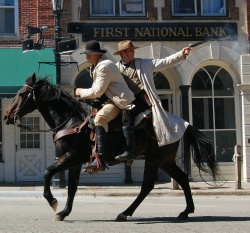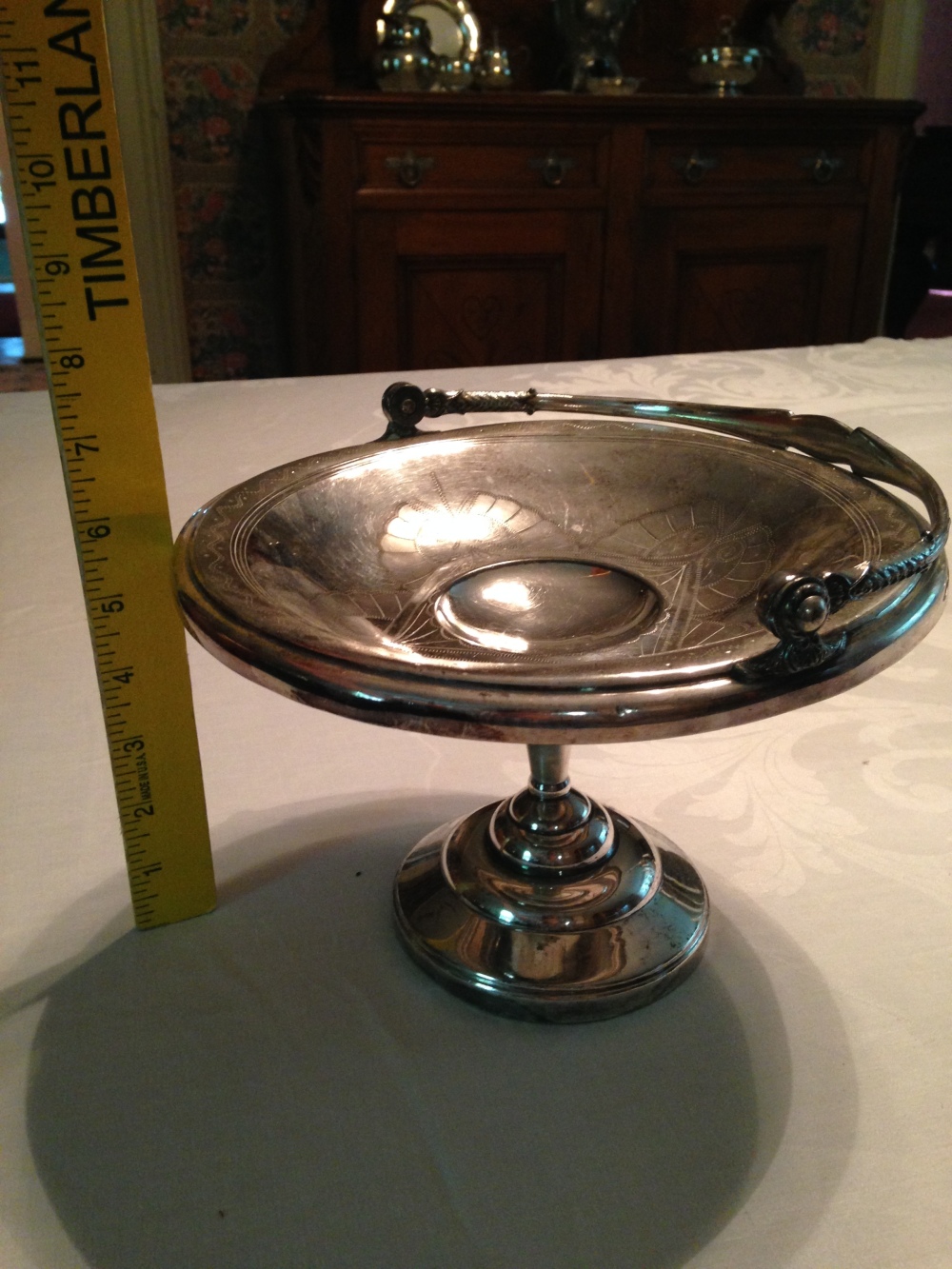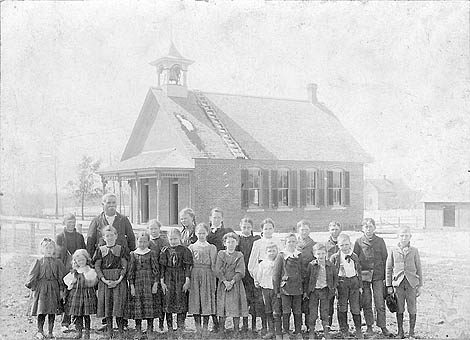This issue: Contents
Tuesday, July 26, 2016
- Editor’s Note
- WCHS News: The Story of the Northfield Raid
- WCHS News: August Events
- What Is This Thing?!
- Old News: Real Life ‘Pokemon’ Hunting
- Featured Article: Memories of Hay Lake School
Folks, I don’t want to alarm you – but summer is on its way out.
Lumberjack Days is fading into the rear view mirror, August is about to start, and the Washington County Fair is next week. (Be sure to swing by our booth to say hi!)
…I’ll give everyone a moment to collect themselves.
But just because we’re at the tail end of summer, that doesn’t mean our calendar at the Historical Society is any less full! Head down to our News Section to read about the next FREE five events and programs over the next month!
And in case you missed it, one of our favorite St. Croix Valley historians, Ken Martens was up at Hay Lake on Sunday discussing the hardships of our pioneer ancestors. Here’s a quick video recap (2:15) of Ken’s program.
Who’s that knocking on the door? Why, it’s another “What Is This Thing?!” challenge!
Over the last few weeks, you may have noticed packs of Millennials roaming around Stillwater – their eyes glued intently to their phones. No, they aren’t zombies (despite any similarities) they’re just enjoying the the “Pokemon Go” craze! As you’ll see in our Old News section, Stillwaterites took their “Pokemon” hunting a bit more seriously back in 1868.
A few issues ago, we took a good look at the history of the Warden’s House, so in this week’s Featured Article, we’ll dive into the history of WCHS’ other flagship museum – the Hay Lake Schoolhouse!
Sean Pallas
Historical Messenger editor and Warden’s House Site Manager
sean.pallas@wchsmn.org
WCHS News
 The Story of the Northfield Raid
The Story of the Northfield Raid
This Sunday, July 31st, at 2:00 PM Hayes Scriven, Executive Director of the Northfield Historical Society visits the Warden’s House to discuss the infamous attempted bank robbery perpetrated by the James-Younger Gang.
On September 7th, 1876, the typically quiet town of Northfield, Minnesota erupted into violence as Frank & Jesse James along with Cole, Jim, & Bob Younger and a number of other desperados attempted a bold broad daylight robbery of the town’s bank. Four were left dead in the ensuing gunfight and Northfield had secured its place in history.
During the free and open to the public program Scriven will detail every bullet fired and every dollar swiped during his city’s most well known historic episode.
More Events
WCHS News
August Events
 Minnesota Wrestling Hall of Fame – Sun. August 7th @ 2:00 PM – Hay Lake School, Scandia
Minnesota Wrestling Hall of Fame – Sun. August 7th @ 2:00 PM – Hay Lake School, Scandia
Carol Castle of the Minnesota Wrestling Hall of Fame discusses the on-going efforts to save & share Minnesota’s rich Pro Wrestling history.
Verne Gagne, a name synonymous with the history of Minnesota, created the American Wrestling Association (AWA) in the 1950s. For decades names such as Mad Dog Vachon, Nick Bockwinkel, Larry “The Ax” Hennig, The Crusher, Baron Von Rascke, and more graced the squared circle throughout Minnesota and the Midwest. In the 1970s the AWA was sweeping the nation, being the largest wrestling promotion in the United States. It was not until the early 1990s when the AWA was officially purchased by World Wrestling Entertainment (WWE).
Castle, who is a die-hard professional wrestling fan has begun to collect and preserve its history and interpret its importance on the state. Housed in Robbinsdale (known as the birth place of wrestling in Minnesota), Castle will speak on the beginnings of creating the Hall of Fame and what it takes to begin such a large venture. This year’s inductees will include Greco-Roman wrestler; Alan Rice, Professional wrestling legend; Stan Kowalski, and hall of fame wrestling coach; John Gregelko. In 2015 the first two inductees were placed in the Hall of Fame, Larry “The Ax” Henning and Verne Gagne.
Outdoor Museum Movie Night Presents: Gulliver’s Travels – Thurs. August 11th @ 7:30 PM – Hay Lake School, Scandia
How many remember going to the drive-in movie theater as a kid? In 2016, drive-in movies are on the decline and the younger generation may never get the chance to feel what it’s like to watch a movie under the stars. This is a chance for all to enjoy that feeling again. The Hay Lake School grounds allow us to project 1939’s “Gulliver’s Travels” on the side of the museum, so all attendees can enjoy the feeling of watching a movie outside.
Free tours of the museum begin at 7:30pm, show time of the film will begin at dusk. Attendees are encouraged to bring a chair or blanket to sit on for the duration of the event. There is even room on the grounds to park a few cars to truly give it that “drive-in movie feeling.” Concessions will be available (popcorn, candy, soda, water, etc.) with all funds going to the Washington County Historical Society.
Gulliver’s Travels is based on seaman Lamuel Gulliver who is the sole survivor of a shipwreck in a distant land whose people are no bigger than peanuts, adventure then ensues. With a run time of 76 minutes, Gulliver’s Travels is a great time for both children and adults. Children will enjoy the music and animated nature of the film while adults will enjoy the “it’s so bad its good” feel to this 1939 classic.
 Ancient Egypt Was Built From Here – Sun. August 14th @ 2:00 PM – Warden’s House Museum, Stillwater
Ancient Egypt Was Built From Here – Sun. August 14th @ 2:00 PM – Warden’s House Museum, Stillwater
Join Dr. Maria Nilsson and John R. Ward archaeologists, founders of the “Friends of Silsila“, & hosts of “Egypt’s Treasure Guardians” on National Geographic, for a discussion of the extraordinarily important ancient Egyptian site, the sandstone pits at Gabel el-Silsila.
Gebel el-Silsila is situated along the Nile River in Egypt and was used as a major quarry from ca. 1500 BCE all the way to around 200 CE. Many of the most famous and powerful pharaohs ordered the construction of ancient Egypt’s most well known temples, such as Luxor and Karnak, from the sandstone harvested at Silsila.
Dr. Nillson and Ward have spent years heading the first ever-comprehensive archaeological survey of the site. Their team’s latest discovery is pinpointing the location of a previously lost 3,400-year-old, 18th dynasty necropolis.
One Room Schoolhouses – Sat. August 20th @ 2:00 PM – Eder School, Oakdale
Before laptops and smartphones, we sent all our kids to one room to learn the 3 R’s.
Learn about Washington County’s one-room school house legacy from Hay Lake School Manager, Dustyn Dubuque.
More Events
What is This Thing?!

What Is This Thing?! (Round 41)
Last issue’s What Is This Thing?! went pretty well! Got a lot of responses, and even better, a lot of correct responses!
In case you missed it, the last item was a gas light spigot. Specifically, this gas light was inside the Warden’s House itself.
Although the house itself was built on the cheap, they did get technological advancements fairly early. Gas lighting was brought into the home by the 1870s (along with steam heat). But even more impressive is the fact that electricity was installed in 1888!
Now, electric lights were definitely an improvement over the technically unsafe gas systems, but both types of lighting were kept in the house for the next decade as neither were particularly reliable in their infancies.
Congratulations to everyone who was able to correctly shed some light on our previous challenge! And thank you for playing!
Onto this week’s challenge!
Can you identify the WCHS artifact photographed above? If you’d care to venture an answer, you can send an email to me at spallas.wchs@gmail.com, tweet @WCHSMN, or post your guess on our Facebook page.
Good luck!
Full Image
Side Image
Old News
Real Life ‘Pokemon’ Hunting
The only way you haven’t heard of the new “Pokemon Go” mobile game is if you’ve been managing to completely avoid any sort of media for the last handful of weeks (and I guess I wouldn’t blame you, the news has been pretty grim lately).
In case you don’t know, this latest fad has countless masses wandering their towns and neighborhoods using their smart phones to desperately search for rare digital monsters. (Seriously, people are spending more time playing Pokemon Go than on Twitter and Facebook).
Even weeks after it’s launch – you can still find plenty of aspiring Poke-Masters hunting around Stillwater.
…well, back in 1868, folks were a bit less excited to see critters in unexpected places.
Local News – Stillwater Republican – July 26, 1868
On Wednesday last Mrs. A. M. Dodd, while going down the cellar stairs of her residence on Third street, near Pine, discovered an unwelcome guest in the shape of a rattlesnake taking his afternoon nap in the cellar window. Not relishing the idea of admitting into her family a member to whom she could not give a cordial welcome she called her husband who was working in his garden nearby and related to him the situation. He at once repaired to the aforesaid window and disturbed the quiet slumber of his-snakeship by dealing him a well directed blow with a hoe, which caused an immediate death. He measures 44 inches in length and has seven rattles. His corpse is preserved and is on exhibition in the window of Mesars. Carli & Kauffman’s drug store.
Editors Note: After some diligent research, I may have uncovered a photograph of said rattlesnake.
Featured Article
Memories of Hay Lake School
by Mildred Swing Zillgitt
Shouts and laughter of eager children have long been silenced. The once dry and trampled playgrounds have succumbed to hay and stubble. Wind and rain against the windowpanes fall on deaf ears, for no one is there to listen. Thus it has been with country schools all over the land. School architecture was generally the same: a door at one end, windows on opposing sides, two cloakrooms, and a belfry…not to forget those all important country johns. Prosaic? Perhaps. But to anyone who attended such an institution, there’s a world of feeling akin to reverence.
 Throughout the 1960s and 70s, Mildred Swing Zillgitt watched many schoolhouses fall to wrecking crews and felt little or no ill will towards the aggressor. However, upon learning that Hay Lake School had been abandoned for a better place of learning, she held her breath…anticipating the worst. As if to compensate, she said to herself, “Abandon if you must! Rip down those venerable walls! Decry them if you wish! But you can never silence those echoes of yesteryear nor destroy the dreams of childhood, for memory lives on forever.”
Throughout the 1960s and 70s, Mildred Swing Zillgitt watched many schoolhouses fall to wrecking crews and felt little or no ill will towards the aggressor. However, upon learning that Hay Lake School had been abandoned for a better place of learning, she held her breath…anticipating the worst. As if to compensate, she said to herself, “Abandon if you must! Rip down those venerable walls! Decry them if you wish! But you can never silence those echoes of yesteryear nor destroy the dreams of childhood, for memory lives on forever.”
But as you know, the Hay Lake school would not be destined for a landfill. In 1978, the Washington County Historical Society purchased the site. When Mildred heard this news, she was “thrilled beyond words.” As her alma mater, Hay Lake held a special place in her heart.
“Though some things have grown misty with forgetting, things I didn’t understand in the past have become meaningful to me now. It is good to unleash childhood memories of those formative years. What I hope to do, if you’ll bear with me, is to recall some of those early sensations…joys, fears, and sharing.
For sentimental reasons, it is customary to preface a recounting of the past with ‘The Good Old Days”. However, those days weren’t all good, believe me. The world I once knew was not altogether carefree nor filled with magic and imagination. Often, fears and apprehensions stalked my pathway. But whoever said that growing up was easy? The recollections of my last years at Hay Lake are blended with mixed emotions. Although school was never better, I would be remiss in saying that jaunty days and happiness abounded, since right about then a transition was taking place in the land. A most significant and unforgettable period in history was in the making – we were hovering in the shadows of a World War. Young and old alike felt the impact of its vicious sting. But memory has a strange and beautiful arithmetic; it can subtract the bad and add only the good things.
The classroom I once knew had streaks of sunshine streaming through the east windows upon rows and rows desks and seats. There was a huge heating stove with a galvanized jacket at the rear of the room. Separate cloakrooms were provided for boys and girls where wraps were hung on hooks along the wall. Beneath the array of clothing was a semicircle of lunch pails. The clothing cubicles were dark and cold. I remember that in winter we’d bring our lunch pails inside and line them up beneath the windows to keep our sandwiches and fruit from freezing solid.
I have recollections of an extravagant display of blackboards on the walls and a modest library in one corner. One space was of particular interests, for it boasted a set of encyclopedia. Plus a huge unabridged dictionary. Close by stood a revolving world globe. A case containing a map of every country in the world was suspended on the wall back of the teacher’s desk. This paraphernalia was the extent of the equipment a teacher had in those days with which to operate a school.
A captain’s chair and desk of yellow oak signified the center of authority, for in that era it was the teacher who governed the classroom. She had an unwritten set of rules we all respected and at least tried to observe. To wit: Not to leave our seat without permission; no talking out loud and no whispering and no scuffling of feet. Two fingers in the air meant, ‘I want to leave the room, please!’ These rigid rules were necessary for eight grades in one room to function properly.
The seating arrangement was always the same in that the seventh and eighth graders occupied the back seats while the small fry sat close to the front. There were grades one through eight, and some years, as many as 36 children were in attendance. I shudder now when I think of the workload projected on one teacher. The assignments alone must have been astronomical.
Each grade recited either seated on long benches or standing in a semicircle, beginning with the first grade, until each had performed in one way or another. You can imagine the activity going on up front at all times. While some kids hovered over their own lessons, completely oblivious to what was going on elsewhere in the room, most of us got our learning from ‘up front’. This very often added to our woes when we came to class unprepared with our own assignments.
Contrary to rules, I was more interested in everyone else’s lessons than my own. History was the most tortuous subject inflicted upon me. I recall one day when my wide-open book lay unattended on my desk. I just couldn’t concentrate on such mundane things as the Lewis and Clark expedition with all those goodies going on up front. Fractions and square root flashing like magic and that fine velvety sound of the long white chalk gliding over the blackboard fascinated me.
Suddenly, it was time for my class to recite. Then came the turning point in my life! While I was standing there in that semicircle, questions bounced back and forth until I was called upon…the whole world stood still, for I knew not a word. Unfortunately, for me at least, the teacher had eyes in the back of her head and had, no doubt, been observing my preoccupation earlier. She was prepared for this and was not about to let me off the hook.
‘Open your book,’ she blazed. ‘Now read that paragraph.’ I did just that. ‘Now close your book and tell me what you read.’ I was so flustered that I froze to the floor. That wasn’t all, for this ordeal was repeated three times over. I glanced around at my classmates whose eyes were hard upon me. Irving glared at me with that look: ‘Gosh, you’re dumb.’ He always knew the answers, both large and small. For some possible escape, I looked down at the floor, where all I could see was an assortment of scuffed shoes.
All that I didn’t forget, but the paragraph I read three times over still hadn’t caught up with me. That was a most terrifying experience when my little world stood still.
A muffled snicker issued from the group as class was dismissed. My ears and faced tinged with embarrassment. What might have seemed, at the time, to be wasted energy proved productive in the long run. After that, I learned to chart routes and journeys of early explorers with the aid of maps. And, in due time, history became my favorite subject, which bears out the fact that the teacher proved her point after all.
My recollections of weather conditions during my school days are blended in a combination of snow, rain, gusty winds and blistering heat, with a smattering of blue skies and gentle breezes. Martha and Dora, who lived but a hop-skip-and-jump from school, never felt the really harsh blasts of winter. But the rest of us all had a mile or more to walk, which was a hardship in itself, especially when roads drifted in for weeks on end. I vividly recall one blizzardy March day, the events of could well have proved catastrophic had it not been for our concerned parents. The telling of this tale could fill a book itself.
Aside from our regular curriculum, we crammed in a course in penmanship, which was known as the Palmer Method. Though a bit ridiculous, it was a blessed relief from our usual humdrum studies. The exercise demanded that we sit up straight with both feet flat on the floor. ‘Hold your pen firmly, but not too rigid,’ the teacher intoned, as she paced up and down the aisles, placing her hand on our backs to be sure our spines were absolutely perpendicular. However ludicrous, it was not a complete loss, I for it was good, sound discipline.
To this day, I cringe when I see clerks and waitresses clutching their pens in a cramped, squeezing position. But then, they never heard of the Method.
Numerous other activities, such as spelldowns, took place in the evenings. I recall and can say with pride that whenever Hay Lake was pitted against other schools, we proved to have some pretty good champions in the art. Then there were those basket and pie socials, which would set the entire community in a flurry. This fostered togetherness and was a means of relaxation during those long winter months before the advent of radio and television.
Seasons came and passed in rapid succession; the grandeur and unspeakable beauty of autumn, the stern glory of winter, then March winds that knew no bounds, and ultimately, summer vacation. Finally, came the day when it was my turn to occupy one of those coveted back seats earmarked for eighth graders only. Yes, I’d earned the distinction now of ‘Upper Classman’. That last year at Hay Lake was, indeed, a memorable one.
While new horizons beckoned to me, I experienced isolated moments of forebodings. Did I really want to be liberated from country school and parental care to face the world with all its perplexities? Where should I go? What would I do? Human nature is a complex thing at best, but to a fifteen year old with growing pains it can be downright devastating. Especially for someone who didn’t know which way she was going. Somehow, though, I managed to make my exodus to new and less carefree frontiers.
For those of us who are growing old, there’s a certain magic in remembering our youth – like fresh winds of Galilee blowing in to recharge and energize our souls. In my reminiscing, I have renewed many fond memories which have lain dormant for many years. And I find that I can still draw from the endless resources of those Golden Years at Hay Lake, where discipline and learning went hand in hand.

 The Story of the Northfield Raid
The Story of the Northfield Raid


